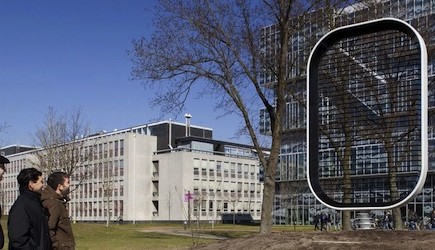Dutch Techies Build Bladeless Wind Power Plant
April 08, 2013
on
on

A wind-driven electricity generator without moving mechanical parts is adorning the lawn of Delft University of Technology, The Netherlands. The Electrostatic Wind-Energy Converter (EWICON) could unobtrusively function in an urban landscape.
Wind turbines supply a significant part of the renewable energy mix. But wind farms meet a lot of resistance from local populations because of noise pollution, flickering shadows and birds getting killed. The EWICON, which looks like wire mesh artistically framed in a giant 0, eliminates these negative aspects. Also, the absence of moving parts reduces maintenance costs significantly.
Prof. dr. Johan J. Smit head of the High Voltage Technology & Management Institute of Delft University explains how the EWICON works. ‘Using high voltage, electrically charged droplets of water are produced in the horizontal elements. At the same time these horizontal elements, which are electrodes, generate an electric field. As the wind forces the electrically charged droplets against this electric field towards the earth, the converter is charged to DC voltages of between 80 and 100 kilovolts. After conversion to AC, this can then be used to supply power to the electricity grid.’
The bladeless electricity generator installed on the University’s campus is a working prototype. The output power is dependent on a variety of factors like the method used to generate the aerosol of charged droplets, the size of the droplets, the flow rate of the liquid, electrode configuration, humidity of the environment and wind speed. Funding is needed to continue the development and upscaling of the EWICON.
Its unobtrusive nature makes the power plant suitable for installation in urban areas. At the same time, its low maintenance requirements makes the EWICON an interesting candidate for off-shore wind farms.
For deeper understanding of the complexity of the system read the 2011 master thesis of Arjan Winters.
EWICON was developed in a collaborative effort of Delft University, Wageningen University and four commercial businesses. Physicist Piet Sonneveld of Wageningen University devised the bladeless wind energy converter and delivered proof of concept in 2002. The prototype was designed by engineer Francine Houben of architecture firm Mecanoo.
Image: Mecanoo.nl
Wind turbines supply a significant part of the renewable energy mix. But wind farms meet a lot of resistance from local populations because of noise pollution, flickering shadows and birds getting killed. The EWICON, which looks like wire mesh artistically framed in a giant 0, eliminates these negative aspects. Also, the absence of moving parts reduces maintenance costs significantly.
Prof. dr. Johan J. Smit head of the High Voltage Technology & Management Institute of Delft University explains how the EWICON works. ‘Using high voltage, electrically charged droplets of water are produced in the horizontal elements. At the same time these horizontal elements, which are electrodes, generate an electric field. As the wind forces the electrically charged droplets against this electric field towards the earth, the converter is charged to DC voltages of between 80 and 100 kilovolts. After conversion to AC, this can then be used to supply power to the electricity grid.’
The bladeless electricity generator installed on the University’s campus is a working prototype. The output power is dependent on a variety of factors like the method used to generate the aerosol of charged droplets, the size of the droplets, the flow rate of the liquid, electrode configuration, humidity of the environment and wind speed. Funding is needed to continue the development and upscaling of the EWICON.
Its unobtrusive nature makes the power plant suitable for installation in urban areas. At the same time, its low maintenance requirements makes the EWICON an interesting candidate for off-shore wind farms.
For deeper understanding of the complexity of the system read the 2011 master thesis of Arjan Winters.
EWICON was developed in a collaborative effort of Delft University, Wageningen University and four commercial businesses. Physicist Piet Sonneveld of Wageningen University devised the bladeless wind energy converter and delivered proof of concept in 2002. The prototype was designed by engineer Francine Houben of architecture firm Mecanoo.
Image: Mecanoo.nl
Read full article
Hide full article


Discussion (12 comments)